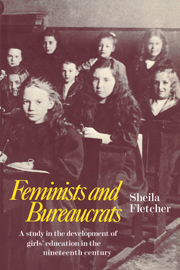Book contents
- Frontmatter
- Contents
- Preface
- Introduction: The Endowed Schools Act
- 1 The shaping of Section 12
- 2 The men who rejected the dead hand
- 3 The money problem
- 4 Opponents
- 5 Supporters
- 6 What was achieved
- 7 The changeover of 1874
- 8 The long haul
- 9 The Charity Commission spirit
- 10 The women's movement in the later years
- Appendices
- Notes
- Select Bibliography
- Index
Introduction: The Endowed Schools Act
Published online by Cambridge University Press: 07 October 2011
- Frontmatter
- Contents
- Preface
- Introduction: The Endowed Schools Act
- 1 The shaping of Section 12
- 2 The men who rejected the dead hand
- 3 The money problem
- 4 Opponents
- 5 Supporters
- 6 What was achieved
- 7 The changeover of 1874
- 8 The long haul
- 9 The Charity Commission spirit
- 10 The women's movement in the later years
- Appendices
- Notes
- Select Bibliography
- Index
Summary
The result of all this movement… was one of the best measures in the history of this government of good measures.
John Morley, Life of William Ewart Gladstone, 1903It is not fashionable these days, either for historians of education or for those interested in women's history, to dwell on the importance of Acts of Parliament. For one thing, we have learnt that there is more to life than ever appears in the statute book; that it will not do to pursue Education Acts ‘like mountain goats, jumping from peak to peak’ nor to subsume the complex progress of women towards emancipation into little more than the campaign for the vote. To devote much time, then, to a minor statute largely concerned with the formal schooling of the Victorian middle classes calls for some sort of justification. And broadly this must rest upon the interest which should attach to the Endowed Schools Act, 1869, as an early essay in social engineering and one which unusually, if not uniquely, singled out girls as beneficiaries.
It is important to understand the bureaucratic pretensions of this measure. If, in the nineties, our education system could be likened by Morant to a house built by someone ‘working spasmodically on odd portions of the structure on quite isolated plans … his very best efforts … rendered abortive by the fact that … he possesses no clearly thought-out plan of the structure as a whole’, it can only be said that this Act was not to blame.
- Type
- Chapter
- Information
- Feminists and BureaucratsA Study in the Development of Girls' Education in the Nineteenth Century, pp. 1 - 11Publisher: Cambridge University PressPrint publication year: 1980



